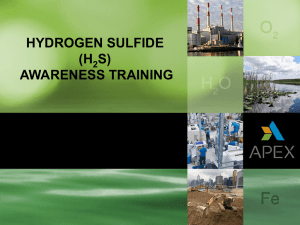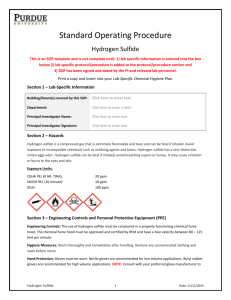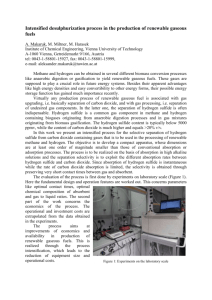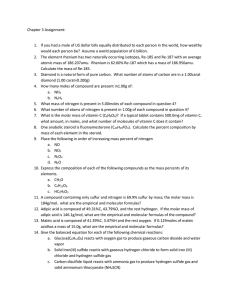Document 13310018
advertisement
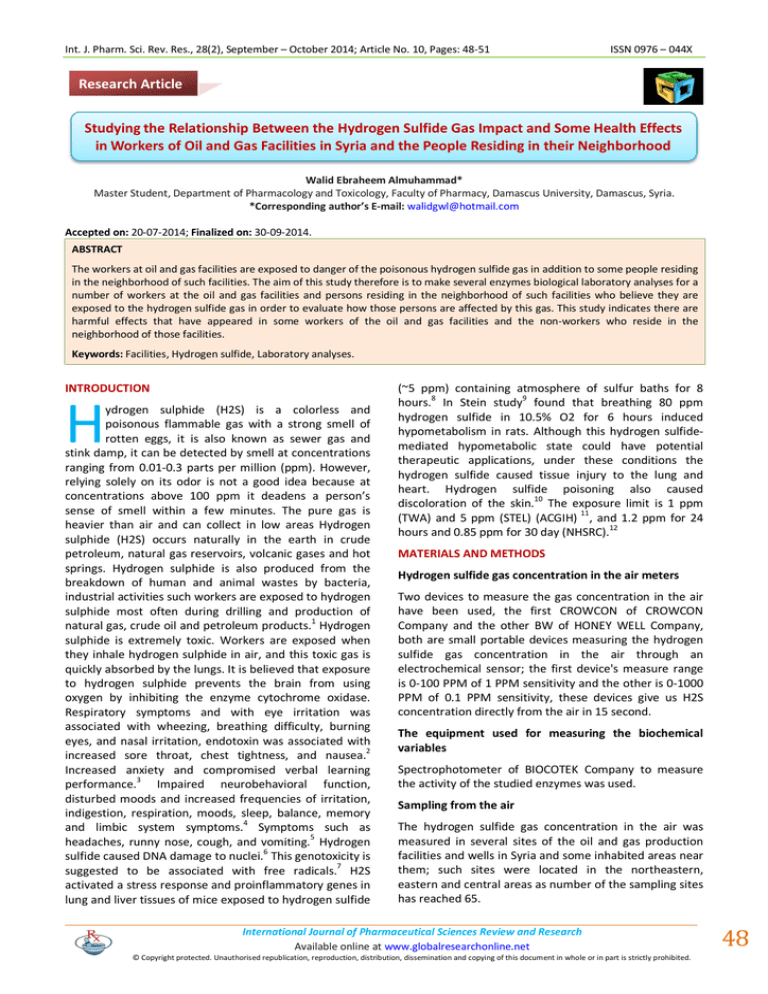
Int. J. Pharm. Sci. Rev. Res., 28(2), September – October 2014; Article No. 10, Pages: 48-51 ISSN 0976 – 044X Research Article Studying the Relationship Between the Hydrogen Sulfide Gas Impact and Some Health Effects in Workers of Oil and Gas Facilities in Syria and the People Residing in their Neighborhood Walid Ebraheem Almuhammad* Master Student, Department of Pharmacology and Toxicology, Faculty of Pharmacy, Damascus University, Damascus, Syria. *Corresponding author’s E-mail: walidgwl@hotmail.com Accepted on: 20-07-2014; Finalized on: 30-09-2014. ABSTRACT The workers at oil and gas facilities are exposed to danger of the poisonous hydrogen sulfide gas in addition to some people residing in the neighborhood of such facilities. The aim of this study therefore is to make several enzymes biological laboratory analyses for a number of workers at the oil and gas facilities and persons residing in the neighborhood of such facilities who believe they are exposed to the hydrogen sulfide gas in order to evaluate how those persons are affected by this gas. This study indicates there are harmful effects that have appeared in some workers of the oil and gas facilities and the non-workers who reside in the neighborhood of those facilities. Keywords: Facilities, Hydrogen sulfide, Laboratory analyses. INTRODUCTION H ydrogen sulphide (H2S) is a colorless and poisonous flammable gas with a strong smell of rotten eggs, it is also known as sewer gas and stink damp, it can be detected by smell at concentrations ranging from 0.01-0.3 parts per million (ppm). However, relying solely on its odor is not a good idea because at concentrations above 100 ppm it deadens a person’s sense of smell within a few minutes. The pure gas is heavier than air and can collect in low areas Hydrogen sulphide (H2S) occurs naturally in the earth in crude petroleum, natural gas reservoirs, volcanic gases and hot springs. Hydrogen sulphide is also produced from the breakdown of human and animal wastes by bacteria, industrial activities such workers are exposed to hydrogen sulphide most often during drilling and production of 1 natural gas, crude oil and petroleum products. Hydrogen sulphide is extremely toxic. Workers are exposed when they inhale hydrogen sulphide in air, and this toxic gas is quickly absorbed by the lungs. It is believed that exposure to hydrogen sulphide prevents the brain from using oxygen by inhibiting the enzyme cytochrome oxidase. Respiratory symptoms and with eye irritation was associated with wheezing, breathing difficulty, burning eyes, and nasal irritation, endotoxin was associated with increased sore throat, chest tightness, and nausea.2 Increased anxiety and compromised verbal learning performance.3 Impaired neurobehavioral function, disturbed moods and increased frequencies of irritation, indigestion, respiration, moods, sleep, balance, memory and limbic system symptoms.4 Symptoms such as 5 headaches, runny nose, cough, and vomiting. Hydrogen 6 sulfide caused DNA damage to nuclei. This genotoxicity is 7 suggested to be associated with free radicals. H2S activated a stress response and proinflammatory genes in lung and liver tissues of mice exposed to hydrogen sulfide (~5 ppm) containing atmosphere of sulfur baths for 8 hours.8 In Stein study9 found that breathing 80 ppm hydrogen sulfide in 10.5% O2 for 6 hours induced hypometabolism in rats. Although this hydrogen sulfidemediated hypometabolic state could have potential therapeutic applications, under these conditions the hydrogen sulfide caused tissue injury to the lung and heart. Hydrogen sulfide poisoning also caused discoloration of the skin.10 The exposure limit is 1 ppm (TWA) and 5 ppm (STEL) (ACGIH) 11, and 1.2 ppm for 24 hours and 0.85 ppm for 30 day (NHSRC).12 MATERIALS AND METHODS Hydrogen sulfide gas concentration in the air meters Two devices to measure the gas concentration in the air have been used, the first CROWCON of CROWCON Company and the other BW of HONEY WELL Company, both are small portable devices measuring the hydrogen sulfide gas concentration in the air through an electrochemical sensor; the first device's measure range is 0-100 PPM of 1 PPM sensitivity and the other is 0-1000 PPM of 0.1 PPM sensitivity, these devices give us H2S concentration directly from the air in 15 second. The equipment used for measuring the biochemical variables Spectrophotometer of BIOCOTEK Company to measure the activity of the studied enzymes was used. Sampling from the air The hydrogen sulfide gas concentration in the air was measured in several sites of the oil and gas production facilities and wells in Syria and some inhabited areas near them; such sites were located in the northeastern, eastern and central areas as number of the sampling sites has reached 65. International Journal of Pharmaceutical Sciences Review and Research Available online at www.globalresearchonline.net © Copyright protected. Unauthorised republication, reproduction, distribution, dissemination and copying of this document in whole or in part is strictly prohibited. 48 © Copyright pro Int. J. Pharm. Sci. Rev. Res., 28(2), September – October 2014; Article No. 10, Pages: 48-51 Sampling from oil and gas facilities workers and the nonworkers residing in their neighborhood A group of oil and gas facilities workers and non-workers residing in the neighborhood of such facilities who believe they were exposed to the hydrogen sulfide gas aged 19 – 56 years excluding smokers, alcoholics and patients of chronic and genetic diseases have been selected for ISSN 0976 – 044X making some enzyme biological analyses including liver enzymes: alanine aminotransferase ALT(SGPT),aspartate aminotransferase AST(SGOT),gamma glutamyl transferase (GGT),alkaline phosphatase (ALP), and comparing them with the analyses of a group of healthy people unexposed to the hydrogen sulfide gas. Table 1: Shows the sampling group The average exposure to H2S during the year (PPM) Group Persons number Region (in Syria) Nature of Group Exposure to H2S 1 2 14 14 Northeastern Eastern Worker in gas facility Worker in gas facility 8.6 16.3 3 12 Northeastern Non-worker live near gas facility 8 hrs/5day a week 8 hrs/5day a week Chronic More 90 times/year 4 15 Northeastern Non-worker No exposure - 6.1 Table 2: The measuring of hydrogen sulfide gas concentrations in some oil facilities and some inhabited areas near them in Syria Site Measure (ppm) Region Nature of site Site Measure (ppm) Region Nature of site 1 2 3 4 5 138,6 11,6 3,8 0,8 1,3 Northeast Northeast Northeast Northeast Northeast Facility Residential Residential Residential Residential 15 16 17 18 19 16 2 20 3 6 East East East East East Residential Residential Well Facility Facility 6 7 8 9 10 0.7 46,6 12,2 2,8 0,6 Northeast Northeast Northeast Northeast Northeast Residential Facility Well Residential Residential 20 21 22 23 24 2 2 4 22 4 East East East East East Agricultural Well Facility Facility Residential 11 12 13 14 8 13 69 2 Northeast Northeast Northeast Northeast Well Well Facility Residential 25 26 27 28 7 4 23 102 East East Intermediate Intermediate Agricultural Well Facility Facility Statistics (SPSS computer program) TStudent test were conducted for statistical comparisons. Comparing between analysis results people of group (1) and group (4) ((Comparing group)) AST: sig (2-tailed) =0.01 RESULTS ALT: sig (2-tailed) =0.006 Hydrogen sulfide gas concentration in the air meters Statistically important statistical difference at 0.05 and 0.01 level of indication. It has been indicated the presence of Hydrogen sulfide gas concentrations in the air at 28 sites whether in some oil and gas production facilities in Syria or some inhabited areas in their neighborhood which in some cases exceeded the allowed limits of exposure, while no presence of the gas concentrations in the rest of the areas has been recorded on the devices. Results of the laboratory analyses for some enzymes It has as well been indicated the presence of considerable impacts as a result of exposure to that gas on certain enzyme analyses in workers of oil and gas facilities and non-workers who are exposed to hydrogen sulfide gas. Comparing between analysis results people of group (2) and group (4) ((Comparing group)): AST: sig (2-tailed) =0.001 ALT: sig (2-tailed) =0.008 Statistically important statistical difference at 0.05 and 0.01 level of indication. Comparing between analysis results people of group (3) and group (4) ((Comparing group)) AST: sig (2-tailed) =0.01 International Journal of Pharmaceutical Sciences Review and Research Available online at www.globalresearchonline.net © Copyright protected. Unauthorised republication, reproduction, distribution, dissemination and copying of this document in whole or in part is strictly prohibited. 49 © Copyright pro Int. J. Pharm. Sci. Rev. Res., 28(2), September – October 2014; Article No. 10, Pages: 48-51 ISSN 0976 – 044X Statistically important statistical difference at 0.05 and 0.01 level of indication. Results of the laboratory analyses for some enzymes in the northeastern area's non-workers Table 3: Results of the laboratory analyses for some enzymes in the northeastern area's workers Table 5: Results of the laboratory analyses for some enzymes in the northeastern area's non-workers Sampling ALT AST GGT ALP The reference values 4-36U/L 8-33U/L 5-40U/L 290U/L 1 22 16 17 180 2 26 22 30 193 3 11 16 20 156 4 25 18 26 171 5 59 38 36 209 6 29 24 20 180 7 45 30 35 233 8 22 19 20 201 9 37 34 18 301 10 20 12 14 146 11 11 16 20 155 12 24 15 12 180 13 30 15 26 167 14 22 18 26 210 There was a statistical difference between the exposed workers and unexposed persons for AST and ALT analysis; a statistically important statistical difference at 0.05 level of indication. Results of the laboratory analyses for some enzymes in the eastern area's workers Table 4: Results of the laboratory analyses for some enzymes in the eastern area's workers Sampling ALT AST GGT ALP The reference values 4-36U/L 8-33U/L 5-40U/L 290U/L 1 15 11 18 156 2 58 37 42 37 3 40 28 16 126 4 18 19 32 180 Sampling The reference values ALT AST GGT ALP 4-36U/L 8-33U/L 5-40U/L 290U/L 1 2 3 4 5 22 26 39 20 33 16 22 48 13 20 17 30 22 15 29 180 193 299 190 172 6 7 8 9 10 30 20 29 11 25 38 20 22 16 18 30 25 21 20 26 144 195 174 156 171 11 12 37 29 50 24 37 20 209 180 There was a statistical difference between the exposed and unexposed persons for AST analysis; a statistically important statistical difference at 0.05 level of indication. DISCUSSION The study has showed the presence of hydrogen sulfide gas concentrations in the air at some oil and gas production facilities in Syria or some inhabited nearby areas, some of which exceeded the allowed limit of exposure to this gas according to (ACGIH) American Conference of Governmental Industrial Hygienists and (NHSRC) National Homeland Security Research Center. It has as well been indicated the presence of considerable impacts as a result of exposure to that gas on certain enzyme analyses in workers of oil and gas facilities and non-workers who are exposed to H2S gas, there was a statistical difference between the exposed and unexposed workers and persons; a statistically important statistical difference at 0.05 and 0.01 level of indication, for enzymes AST and ALT and this results compatible with the study of (HOOSER 2000)13 and (Van Aalast 2000).14 5 9 9 15 109 6 40 35 26 188 7 38 23 32 188 8 22 18 20 156 9 20 15 18 174 10 19 13 20 138 11 22 18 22 166 CONCLUSION 12 16 11 18 222 13 29 27 25 175 14 51 47 41 156 Some oil facilities pollute the air with hydrogen sulfide gas in these faculties, exposing thus their workers and non-workers who reside in their neighborhood to the danger of such gas and its negative impacts on health. There was a statistical difference between the exposed workers and unexposed persons for AST and ALT analysis; a statistically important statistical difference at 0.05 and 0.01 level of indication. It then could be said that hydrogen sulfide gas has an obvious effect on some values of the enzyme biological features in the persons who are exposed to this gas; as this gas also causes several harmful health impacts due to exposure. The hydrogen sulfide changes certain values of the enzyme biological features in the people who are exposed to this gas; and this gas causes harmful impacts on the health of the persons who are exposed to this gas. International Journal of Pharmaceutical Sciences Review and Research Available online at www.globalresearchonline.net © Copyright protected. Unauthorised republication, reproduction, distribution, dissemination and copying of this document in whole or in part is strictly prohibited. 50 © Copyright pro Int. J. Pharm. Sci. Rev. Res., 28(2), September – October 2014; Article No. 10, Pages: 48-51 ISSN 0976 – 044X It is recommended to take measures and procedures for and gas facilities with the aim to avoid its negative effects reducing the hydrogen sulfide gas emission from the oil on environment and humans. Studying a number of the impacts suffered by some oil facilities Workers and non-workers residing in their neighborhood who believe they were exposed to inhaling of the hydrogen sulfide gas Table 6: Some health symptoms resulting from exposure to hydrogen sulfide gas Story Age and Sex Source of Emissions Exposure time Symptoms Story 1 Male 51 Oil and gas facility Ongoing occupational headache, fading of consciousness,nasal irritation, balance and memory impairment, nosebleeds, nerve inflammation. Story 2 Male 35 Oil and gas facility Ongoing occupational shortness of breath,Oblurred vision, memory impairment lack of energy,and strength, occasional diarrhea, loss of libido, abnor mal heart rhythm,and anxiety-like attacks . Story 3 Female 54 Sour natural gas wells Ongoing residential severe sinus headaches, blistering of the skin when showering, severe burns on the bottoms of her feet, fatigue, vomiting. Story 4 Male 43 Sour natural gas wells Ongoing residential chronic sore throat, coughing, headaches, congestion , insomnia, occasional nosebleeds, and lack of energy, burning eyes. heart palpitations. Story 5 Male 38 Oil and gas facility Ongoing residential bloody nose burning eyes, throat itching, and itching all over, severe headaches, severe rashes. Story 6 female 44 Sour natural gas wells Ongoing residential headaches, hypersensitivity of the skin, concentrations proble ms, eye irritation, problems sleeping,general pain, low muscle strength, problems with memory retention, balance problems. nasal respiratory epithelial injury, Toxicol Path, 36, 2008, 560-567. REFERENCES 1. ATSDR, Toxicological profile for hydrogen sulfide. U.S. Department of Health &Human Services, Public Health Service, Agency For Toxic Substances and Disease Registry, Atlanta, Georgia, 2006. 8. KM Stuhlmeier, J Broll, B Iliev, NF KappaB independent activation of a series of proinflammatory genes by hydrogen sulfide, Exp Biol, 4, 2009, 1327-1338. Med 23. 2. L Schinasi, RA Horton et al., Air pollution, lung function, and physical symptoms in communities near concentrated swine feeding operations, Epidemiology, 22, 2011, 208-215. 9. Stein, Z. Mao, et al., Metabolic and cardiac signaling effects of inhaled hydrogen sulfide and low oxygen in male rats, J Appl Physiology, 112, 2012, 1659-1669. 3. N Fiedler, H Kipen, et al., Sensory and cognitive effects of acute exposure to hydrogen sulfide. Environ Health Persp, 116, 2008, 78-85. 10. Milroy, J Parai, Hydrogen sulphide discoloration of the brain, Forensic Sci. Med Pathol, 7, 2011, 225-226. 11. ACGIH, Hydrogen sulfide: TLV chemical substances 7 edition documentation. Cincinnati, OH. American Conference of Governmental Industrial Hygienists publication, 2010, #7DOC-316. th 4. KH Kilburn, JD Thrasher, et al., Low-level hydrogen sulfide and central nervous system dysfunction, Toxicology and Health, 26, 2010, 387-405. 5. S Godbout, SP Lemay, et al., Swine production impact on residential ambient air quality, J.Agromed, 14, 2009, 291298. 12. T Marshall, D Dorman, et al., Provisional advisory levels (PALs) for hydrogen sulfide (H2S), Inhale Toxicology, 21(S3), 2009, 56-72. 6. MS Attene-Ramos, GM Nava, et al., DNA damage and toxicogenomic analyses of hydrogen sulfide in human intestinal epithelial FHs 74 Int cells, Environ Mol Mugagenesis, 51, 2010, 304-314. 13. SB.Hooser, W. Van Aalst, M. Kiupel, et al., Acute Pit Gas (Hy drogen Sulfide)Poisoning in Confinement Cattle, J. Vet. Diag n. Invest, 12, 2000, 272 - 275. 14. 7. ES Roberts, RS Thomas, DC Dorman, Gene expression changes following acute hydrogen sulfide (H2S)-induced JA.Van Aalst, R. Isakov, J.D. Polket al., Hydrogen Sulfide Inhalation Injury, J. Burn Care Rehab, 21, 2000, 248 - 253. Source of Support: Nil, Conflict of Interest: None. International Journal of Pharmaceutical Sciences Review and Research Available online at www.globalresearchonline.net © Copyright protected. Unauthorised republication, reproduction, distribution, dissemination and copying of this document in whole or in part is strictly prohibited. 51 © Copyright pro

